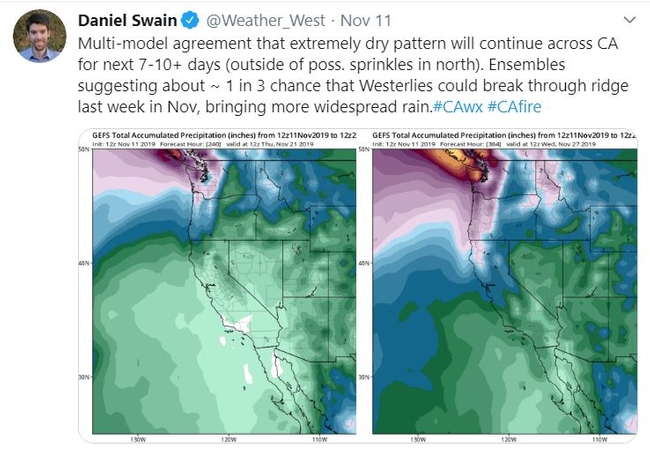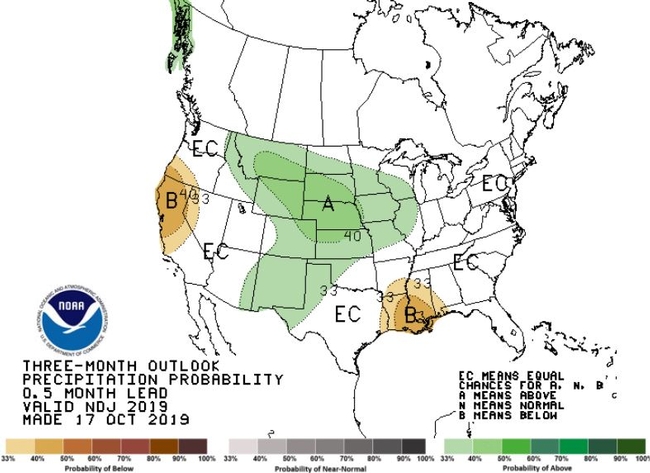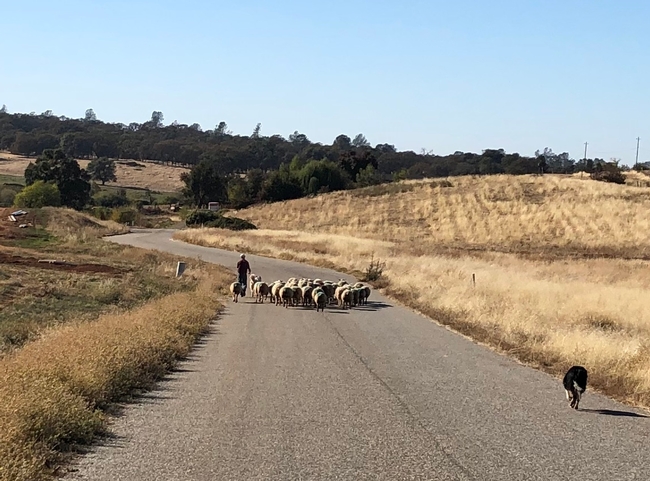Last Saturday evening, the Tahoe Cattlemen's Association held it's annual membership dinner. Ranchers from Placer and Nevada Counties sat down to a wonderful tri-tip dinner prepared by the Del Oro High School FFA chapter. But despite the great meal and the enjoyable company, many were understandably concerned about the lack of rainfall. And as with any gathering of ranchers in Northern California this November, drought has begun creeping back into conversations here in the Sierra Foothills. When I jokingly asked who could remember the last time it had rained this fall, there was nervous laughter.
For rangeland livestock producers, drought is a different phenomenon than it is for crop farmers or urban dwellers; the dry spell we've experienced over the last month-and-a-half is no exception. Those of us who graze livestock on annual rangelands in Northern California rely on fall precipitation to germinate our fall/winter forage, and to replenish stock ponds and seasonal creeks for stock water.
This year, some parts of the Sierra foothills received a germinating rain in mid/late September. We actually had green grass on some of the annual rangelands where we graze our sheep near Auburn. Unfortunately, since October 1, we've measured just 0.02 inches of rain here at the UCCE office in Auburn. The warm temperatures and dry north winds we had in October pulled moisture out of the soil; the grass that got started in September has mostly died. PG&E's public safety power shutoffs and an unusually abrupt end to irrigation water deliveries in Placer and Nevada Counties have left many ranchers scrambling to provide drinking water to their livestock.

While these forecasts can be depressing, I also know that conditions can change rapidly (and counter to what the weather experts predict). From October 2013 through the end of January 2014, for example, we measured less than 4 inches of rain in Auburn; in February 2014, we received almost 9 inches! More recently, in December 2017 we 
Given the lack of green forage on our annual rangelands at the moment, and the lack of stormy weather on the horizon, what does planning for the worst look like? What actions should we be taking now to reduce the impact of both short-term and long-term drought?
Develop a Forage Budget: Most of us stock our grazing land conservatively - we try to manage our grazing during the spring and summer months to make sure we have fall feed. But do you know how much feed you actually have this fall? Do you know how many days of grazing you have before your fall feed is gone? Since the 2013-14 drought year, we've kept track of our forage supply and demand (or carrying capacity and stocking rate). Rather than use the standard unit of an Animal Unit Month (or AUM, the amount of forage consumed by a 1000-lb cow and her calf in one month), we track sheep days per acre. Granted this measurement is very specific to OUR sheep, but it gives us a useful estimate of our specific supply and demand. In the last two weeks, we've analyzed our winter pastures and determined that without forage growth, and with our current sheep inventory, we'll run out of feed in mid/late January. This is not a happy discovery, obviously, but it does help us focus on our options for addressing this shortfall.
Increase Forage Supply: You may have heard the adage, "Don't feed your way out of a drought" - you may have even heard it from me! And while feeding hay quickly becomes prohibitively expensive, there may be other ways to increase forage supply. In our case this fall, a friend offered us 40 acres of alfalfa stubble for the sheep. Instead of moving to our winter pastures this weekend, we'll save that forage for late December. Other options might be talking with a neighbor about an ungrazed property, or even hauling stockwater to an under-utilized portion of your own ranch. Obviously economics come into play here, too - is hauling water or building fence more expensive than feeding hay? That question will be answered differently for every operation!
Decrease Forage Demand: Selling animals is never an easy decision. One of the most difficult days in the 15 years we've raised sheep commercially was the day in January 2014 when I sorted off bred ewes to haul to the auction - we were out of forage and weren't sure when it would rain again. That said, giving some thought to the animals you could sell - or those you'd keep at all costs - helps make that decision easier. This year, we've prioritized the following animals for sale if the dry weather persists:
- Open/cull ewes
- Older rams
- Excess feeder lambs
- Replacement ewe lambs
- Old/thin bred ewes
Given the cost of hauling sheep to the auction, we want to make sure we have more than one or two; that said, when the sheep come off the alfalfa next month, the cull ewes, older rams, and excess feeder lambs will be sold. We'll save forage for the bred ewes and the replacement ewe lambs.
Selling breeding females is a more difficult decision for us. We can't simply go to the auction when it starts to rain and purchase bred ewes that fit our system and our forage resources; indeed, we're still recovering from selling sheep in 2014. And selling an asset (a ewe lamb or a heifer, for example) means we forego the future income she'd produce. We need to compare the money we'll save in the short term (by not having to buy feed) with the income we'll lose by selling breeding animals. There are a number of more sophisticated economic analysis tools we can use to consider these types of decisions.
Develop Stock Water Infrastructure: Fall stock water is often a limiting factor for many rangeland operations. If ponds haven't filled and creeks aren't running, pastures can't be grazed. While long term solutions (like drilling wells or installing water tanks and troughs) may be expensive and time consuming, short term solutions (like hauling water) may allow us to access additional forage resources. For example, in the winter of 2014-2015, I managed the cattle at the UC Sierra Foothill Research and Extension Center in Browns Valley. As you might recall, that winter was also exceptionally dry. In January, we realized we had more than 20 acres of grass growing along the road system on part of the facility - grass that was outside of our pastures. By hauling water to portable troughs placed on the road, we were able to graze this otherwise unusable forage. And we were able to give the regular pastures a much-needed rest. Hauling water, in other words, bought us time (and forage).
Because ranches are also businesses, we need to consider the financial, economic, and tax consequences of our drought strategies, as well. The UC Rangelands Drought Information Hub has a number of outstanding resources on these topics, as well as links to long-range forecasts. And I'm happy to help you walk through these considerations on your own operation - we can develop a forage budget, talk about water development, and discuss other drought management strategies. In the meantime, remember that staring at your weather app and cursing the weather forecast (as I have done) are not effective drought strategies!
